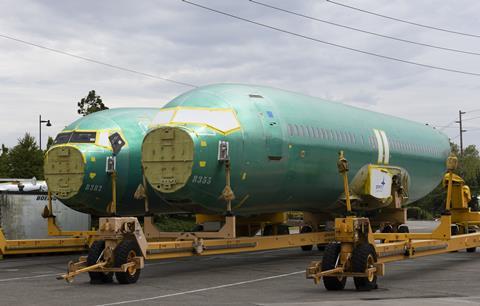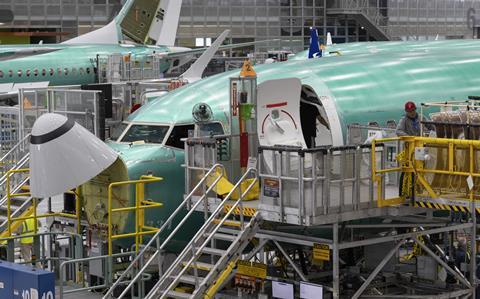The Federal Aviation Administration has given Boeing a 90-day deadline to submit a plan detailing how it intends to address quality-control concerns recently identified by FAA investigators and by a separate safety review panel.
Agency administrator Michael Whitaker informed Boeing chief executive David Calhoun and company safety executives about the requirement on 27 February during an “all-day safety discussion” at the FAA’s headquarters in Washington, DC, the regulator said on 28 February.

“Administrator Whitaker told Boeing that he expects the company to provide the FAA a comprehensive action plan within 90 days that will incorporate the forthcoming results of the FAA production-line audit and the latest findings from the expert review panel report,” the agency adds.
Asked to comment, Boeing says: ”By virtue of our quality stand-downs, the FAA audit findings and the recent expert review panel report, we have a clear picture of what needs to be done.”
”Transparency prevailed in all of these discussions,” it adds. “Boeing will develop the comprehensive action plan with measurable criteria that demonstrates the profound change that administrator Whitaker and the FAA demand.”
The FAA launched an audit of Boeing’s 737 Max production system, including of Wichita-based fuselage supplier Spirit AeroSystems, following the 5 January in-flight blow out of a door plug on an Alaska Airlines 737 Max 9. Boeing assembles 737 Max at its site in Renton near Seattle.
Bolts intended to secure the 737 Max 9’s door plug were missing when the plug failed, according to a preliminary accident report from the National Transportation Safety Board, suggesting Boeing may not have installed the bolts prior to delivering the jet to Alaska. Boeing CEO Calhoun has already acknowledged Boeing’s responsibility for the incident.
The FAA’s audit aims to broadly evaluate the safety and quality of Boeing’s 737 Max production system. The agency sent about two dozen inspectors to Boeing facilities and half a dozen inspectors to Spirit as part of the review, the agency has said. It has not completed the audit.

Separately, on 26 February an independent safety review panel released a report finding that numerous safety issues remain within Boeing’s 737 Max production system. Those issues include unclear safety processes (creating confusion among employees), concerns about the company’s self-regulation system and warnings about Boeing’s reduced consideration of “human factors” as part of its aircraft design.
“The expert panel also found a lack of awareness of safety-related metrics at all levels of the organisation,” the report says.
The FAA had formed the safety panel, composed of experts from various sectors of the aviation industry, as required by a 2020 law.
Boeing now has 90 days to tell the FAA how it will address shortcomings identified by both the panel and FAA audit.
“Boeing must commit to real and profound improvements,” says FAA administrator Whitaker. “Making foundational change will require a sustained effort from Boeing’s leadership, and we are going to hold them accountable every step of the way, with mutually understood milestones and expectations.”
Boeing must tell the FAA how it intends to “mature its safety management system”, and how it will integrate that system into its quality management system, the FAA says. Linking those chains “will ensure the same level of rigour and oversight is applied to the company’s suppliers”.
As part of the audit, the FAA has prohibited Boeing from expanding 737 Max production, though the agency has not specified whether that mean it has capped physical expansion (Boeing is working to open a second 737 Max production site in Everett) or capped Boeing’s 737 Max production rate.
Boeing has said its suppliers are running at a rate of 38 jets monthly, but the rate at which Boeing is actually finishing 737 Max – rolling completed jets out of its Renton site – is much slower, analysts say.
Story updated on 29 February to include comments from Boeing.


























